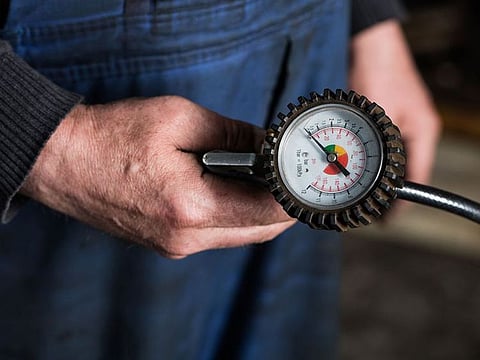Summer is here. Have you checked your tyres?
Vehicles in UAE have to deal with hot climate, that is why regular tyre check is a must

Dubai: With the temperature steadily rising and intense summer heat just around the corner, authorities and road safety experts have again raised awareness on tyre safety to prevent accidents and ensure protection of all road users.
Tyres are the only part of the vehicle that come in direct contact with the road surface and tyre safety is paramount as tyre-related accidents cause around five per cent of the UAE traffic death toll, according to reports.
Experts say having the correct tyre pressure is vital to ensure good gas mileage as wells as better handling and longer tyre life for the car. Tyres must also be replaced if there are other signs of wear or damage — for example, cracks or cuts in the sidewall, parts of the tread band are damaged and if the remaining tread depth is below 1.6mm at any part of the tyre tread band.
Tyre age
Vehicles in the UAE have to deal with hot climate. That is why regular tyre check is a must and authorities have strict rules on tyre age. According to Dubai’s Roads and Transport Authority (RTA), vehicles using tyres that are more than five years past their date of manufacturing are not allowed on UAE roads.
With summer heat sometimes reaching up to 50 degrees Celsius, old and worn-out tyres can burst, leading to horrific road accidents.

He explained: “It’s simple science: Cold contracts; heat expands. The tyres aren’t what support the weight of your car, it’s the air in the tyres, and it’s usually kept at a temperature of around 32 pounds per square inch (PSI).”
PSI refers to the minimum amount of air pressure needed to support the vehicle at its maximum load.
Sanchini explained: “The rule of thumb is for every 10 degrees Celsius change in ambient temperature, tyre pressure increases by approximately 1 PSI, even when not driven. While this doesn’t sound like much, remember that there is only 30-35 PSI in the tyres of passenger vehicles. A few extra bars of air pressure can make a big difference to a tyre, and cause it to pop. Even in the event of that not happening, over-inflation can interfere with braking and cause premature wear and tear.”
Safe travels

He further said: “Checking your vehicle a couple of days prior to the journey/road trip is preferred. Avoid checking your car the night before to avoid surprises. Start with a visual examination of tyre condition and wear in well-lit conditions. Check the tyre tread depth as a worn-out tread can result in loss of traction. Also make sure to check the spare wheel and have it in top shape just to be on the safe side. The spare wheel is often overlooked, but in an emergency situation, it can be the difference between being stranded and delayed.”
He added: “No matter how long the trip is, keep an eye on how much you pack and how much weight it will add on. An overloaded car might not be able to take the extra weight and perform at its full capacity, also impacting the tyre performance. Always carry a puncture repair kit with a tyre inflator. It is fairly easy to use and can be a saviour in an emergency situation,” he added.
Tyre safety checklist:
Tyre safety checklist:
Follow RTA recommendation to replace tyres no later than five years, or earlier if the remaining tread depth is below 1.6mm at any part of the tyre tread band. Tyres must also be replaced if there are other signs of wear or damage, including cracks or cuts in the sidewall or when parts of the tread band are damaged. *Use only reputable branded and certified tyres. Avoid fitting tyres that may be substandard and therefore potentially unsafe. *Use the correct tyre type and dimension for your vehicle. Refer to the vehicle owner’s manual or ask for expert advise if not sure. *Check the tyre pressures at least once a month using a reliable or calibrated gauge. The recommended pressures are quoted in the vehicle owner’s manual or on a sticker usually attached to a door frame or fuel cover. *Avoid driving at lower tyre pressure than those recommended by the vehicle manufacturer. Inflating tyres with nitrogen instead of air can help maintain pressure stability for longer period. *It is highly recommended that all four tyres are replaced at the same time, especially on permanent four-wheel drive vehicles to avoid mechanical damage. If only two tyres are replaced on a two-wheel drive vehicle, it is recommended that the new tyres be fitted to the rear axle for vehicle stability and safer handling. *Front and rear tyres may be permutated (commonly called rotated) every 10,000km or as advised by the vehicle manufacturer, to even out the wear. A wheel balance and alignment check at this time will help the potential life of the tyre to be fully realised, as well as ensure safer driving. *Respect the load and speed capabilities of the tyres fitted to the vehicle by not exceeding them. *Avoid driving over or near hazardous objects that could damage the tyres and make them unsafe or unfit for service, for example, rocks, glass, potholes, kerbs etc. *Check the age of the spare tyre, condition and air pressure to avoid having a spare tyre that is unfit for use when needed.
Sign up for the Daily Briefing
Get the latest news and updates straight to your inbox


